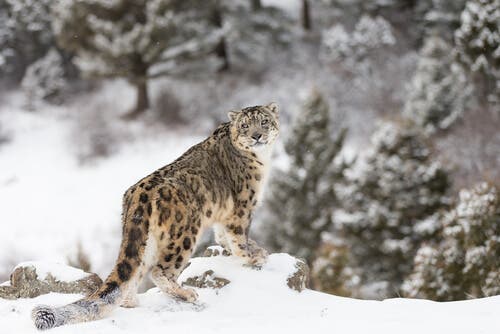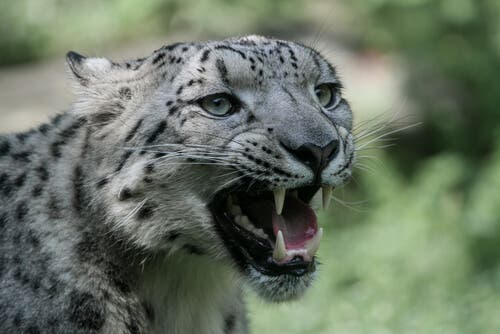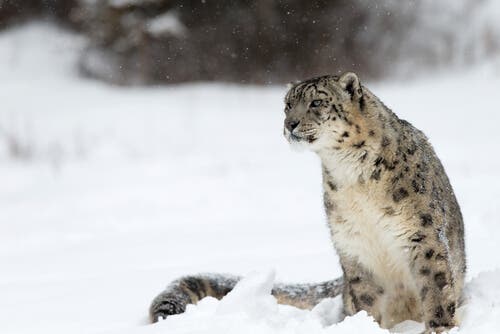Snow Leopard - Characteristics, Behavior and Habitat

The snow leopard or Panthera uncia is one of the most important predators in the Central Asian mountain ranges. This feline is equally feared and admired by Tibetan cultures and their shepherds. Not only that, but this iconic carnivore can live up to 6,000 meters (20,000 feet) above sea level.
The inhospitality and remoteness of their habitat, together with their shyness and fur, make it a rather mysterious carnivore.
Characteristics of the snow leopard
This cat is smaller than other large predators. In fact, it can reach about 165 pounds, although the normal weight is between 66 and 132 pounds. It has a shorter, more robust body than other cats. However, they have one of the longest tails of all cat species.
The animal’s coat is thick and of different degrees of gray with black flecks. Also, their chest is white and they have yellowish-brownish spots in some parts of their body. Their eyes are pale green or gray, which is rare in large cats.
The snow leopard must adapt to cold temperatures and has several other adaptations such as the aforementioned compact body covered by thick fur. In addition, their ears are relatively small and furry, and their wide paws act as “snowshoes.” These are similar to those of the polar bear.
This feline’s tail is one of its main adaptations. It isn’t only helpful in cold weather but also in their usual rocky habitat. This appendage is actually rather fat and covered in hair. In fact, they often wear it as a scarf at night. The length of their tail helps them balance on the cliffs where they inhabit. This is where they take some of the longest jumps — some of the most amazing in the animal kingdom.

The snow leopard has a prolonged nasal cavity that allows them to warm up in the cold Himalayan air. A curious fact is they cannot roar because although their hyoid is similar to that of the so-called “big cats,” they have no other morphological adaptations in the larynx.
Snow leopard behavior
Like other cats, these are solitary animals that only get together for copulation and for the coexistence between mothers and offspring during the cub’s first months of life. Normally, each animal has its own territory that can reach about 120 square miles. This is because they depend on the volume of prey in that space.
The snow leopard marks its territory with urine or by rubbing against a rock. It’s a way of communicating and indicating its territory and routes. These cats are mainly active during sunset and sunrise.
As for their hunting habits, they can be scavengers but are also good hunters and can kill prey that’s four times their weight such as horses or camels. Their most common prey are wild goats, such as the bharal, the Himalayan tar, the markhor, and the argalí.
Interestingly, a percentage of their diet is made up of simple grass, something rather rare in cats.
Sometimes the snow leopard attacks the cattle of traditional herders in Nepal and adjacent areas. Thus, there’s a conflict similar to the one that occurs in Europe with ranchers and wolves. This is remedied by conservation entities and governments to try to prevent their extinction.

Habitat
The snow leopard inhabits mountainous areas of Siberia, Russia, Pakistan, Mongolia, Tibet, India, Nepal, or Uzbekistan. They live about 6500 to 20000 feet high on mountain slopes and snowy peaks.
Even though their distribution is relatively wide, and they have recently been declared to a lesser degree of threat, the last 4,000 to 9,000 snow leopards are at risk from poaching and climate change.
As a consequence, these cats withdraw to higher altitude areas where there’s less chance to catch prey.
Despite this, the inhabitants of the mountainous domains of this emblematic animal are loathe to losing them. The snow leopard is part of the culture of all the countries it inhabits and a symbol of many heraldic elements.
People there are aware of an overwhelming reality: if the snow leopard disappears, much of the culture of the last peoples of the Asian mountains will also disappear. We sincerely hope this beautiful cat survives.
All cited sources were thoroughly reviewed by our team to ensure their quality, reliability, currency, and validity. The bibliography of this article was considered reliable and of academic or scientific accuracy.
- Yianfa, L. I. A. O., Huanwen, L., Dening, L. I. O. U., Shuren, X. U., & Binkui, Y. U. A. N. (2011). A preliminary study on the rearing and breeding of ounce, Panthera uncia. Acta Theriologica Sinica, 6(2), 93.
